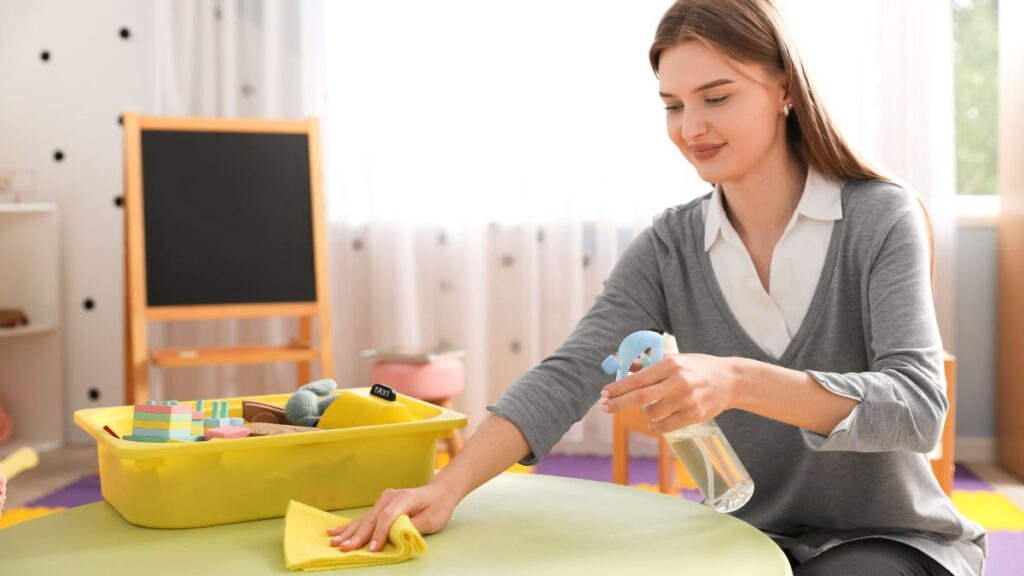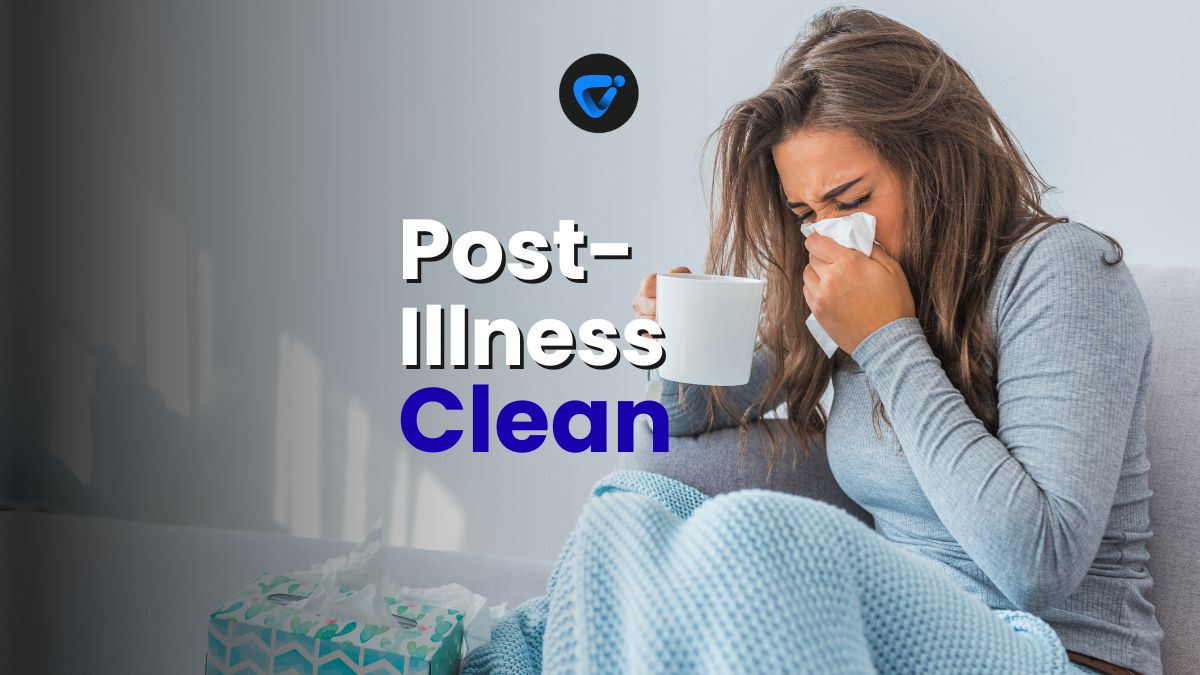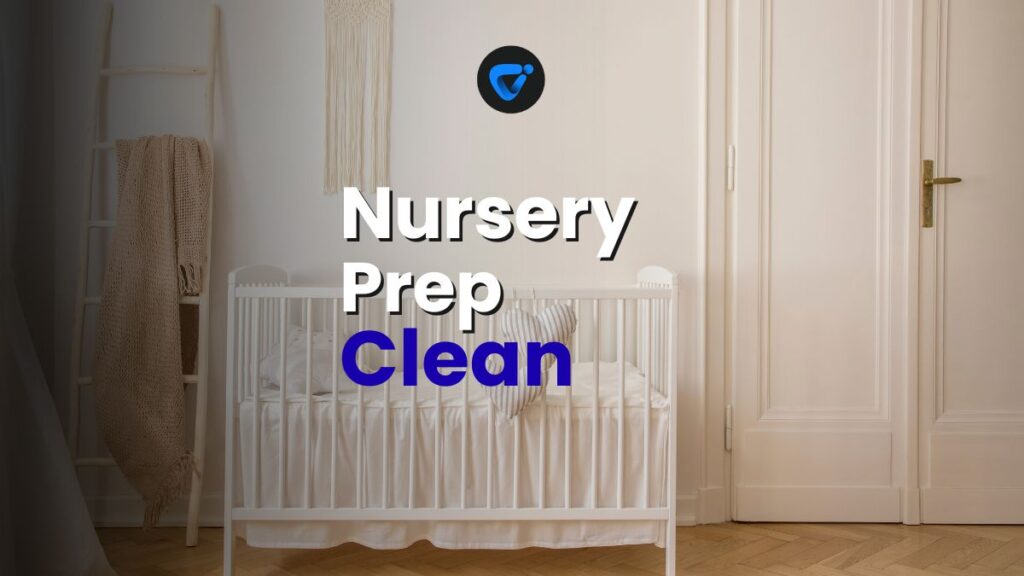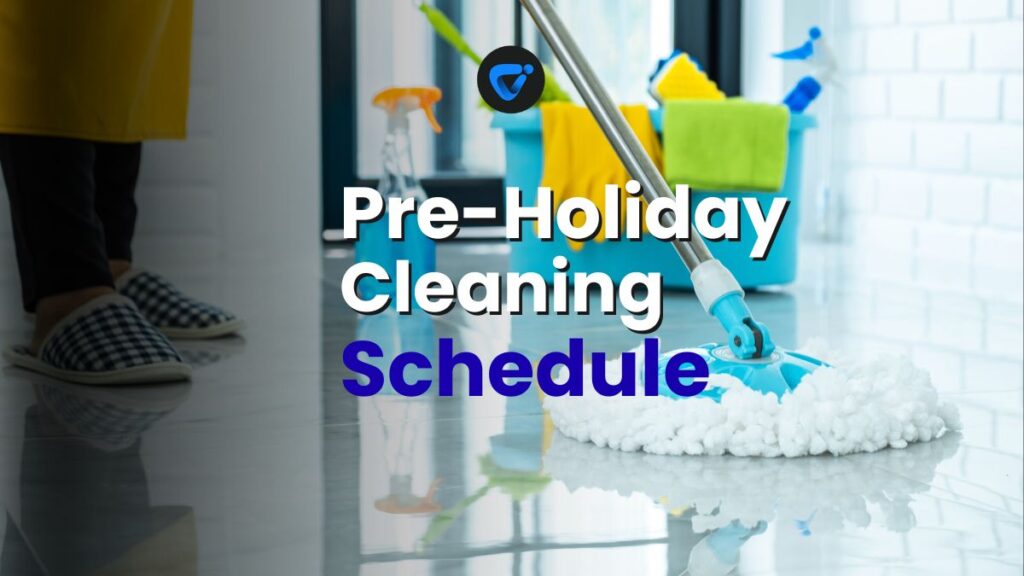
Expecting a new family member brings a unique mix of excitement and nervousness. Tucked inside the swirl of emotions lies one vital task: baby arrival cleaning. Your home’s environment will soon shape your baby’s earliest experiences.

Post-Illness Sanitizing to Keep Household Germs Aw
Keep your home germ-free after illness with simple sanitizing steps. 🧼 Learn how to disinfect surfaces effectively and protect your family.
Every surface, corner, and cherished nook quickly transforms from a routine backdrop to a place your baby may explore. Baby arrival cleaning isn’t about perfection, but safety, calm, and a gentle welcome for your newborn. The tiniest guests inspire the biggest changes.
Throughout this game plan, you’ll discover cleaned room sequences, supply lists, real-world scripts, and room-by-room checklists—all designed to ease your prep. Dive in to create a safe foundation for your newest family member’s arrival.
Create Your Safe Home Base Before Baby’s Debut
Establishing a safe and healthy environment is the first rule of baby arrival cleaning. Prepping early takes pressure off, so you can focus on bonding when your newborn arrives.
Getting every room ready requires a checklist, a cleaning schedule, and targeted supplies. For smooth results, start with one small area—seeing progress motivates you to keep going without feeling overwhelmed.
Room-By-Room Walkthrough for Maximum Impact
Start in your baby’s future nursery. Remove dust from baseboards, vents, and light fixtures. Launder bedding and curtains, and sanitize nearby handles and knobs. Then, move on to living areas, focusing on floors and surfaces near baby gear.
In the kitchen, target countertops, cabinet pulls, and any appliances you might use while holding baby. Sanitizing feeding-related areas ahead of time streamlines bottle prep—even at 3 am.
Bathrooms need special attention: disinfect changing mats, thoroughly clean sinks and faucets, and tidy any open shelving where baby items might be stored. Keeping cleaning products locked away also prevents mishaps.
Staging a One-Day Deep Clean Sequence
Dedicate a weekend day to a full sweep. Invite one person to assist—assign tasks like vacuuming and laundry while you wipe surfaces. Break the work into two-hour spurts and take short rest breaks to stay refreshed.
Set a timer for each phase: thirty minutes dusting, one hour vacuuming, then rotate jobs. If you say, “Let’s finish the nursery before lunch,” you create momentum that keeps everyone accountable and keeps cleaning on track.
End your deep clean by safely storing all supplies out of reach. Open windows when you can—fresh air quickly clears out any remaining cleaning odors, and your baby’s sensitive lungs will thank you.
| Room | Key Focus | Main Supplies | Immediate Action |
|---|---|---|---|
| Nursery | Crib area, floors | Non-toxic wipes, HEPA vacuum | Launder linens, disinfect furniture |
| Bathroom | Sinks, changing station | Disinfectant, microfiber cloths | Scrub faucet, sanitize mats |
| Kitchen | Counters, appliances | Natural surface spray, sponges | Wipe handles, clear prep areas |
| Living Room | Surfaces, seating | Pet hair roller, gentle cleaner | Vacuum furniture, mop floor |
| Entryway | Shoe area, mats | Disinfectant spray, rug cleaner | Shake out mats, wipe handles |
Pinpoint Priority Zones and Clear Out the Clutter
Zeroing in on clutter hotspots is essential to effective baby arrival cleaning. Focus on commonly trafficked spaces: the main entryway, living room, and surfaces at adult hand-level. These frequently collect everyday mess and stray baby items.
Visualize your daily routines. If you’ll set down your car seat near the door or need a tidy surface to change diapers in the living room, these areas must stay organized and debris-free.
Decluttering Mini-Checklist
Think of decluttering as opening up breathing room for your family. Start by gathering all non-baby items in a laundry basket. Remove shoes, bags, and clutter not essential for newborn care.
- Corral scattered magazines into a tote for donation so tables stay open for bottles and clean burp cloths within reach.
- Clear shoes and bags from hallways to create a direct, unobstructed pathway when you’re carrying your baby or gear inside.
- Stash mail and loose papers in a labeled folder for quick sorting. This way, you won’t misplace important documents during newborn sleep deprivation.
- Donate or store decor that’s fragile, sharp, or easy for small hands to access, creating a safer, simpler space with fewer breakage worries.
- Keep only essential remote controls and electronics on open shelves, then use bins to store chargers and extras that otherwise create messy distractions.
Now, designate one bin or basket per room for baby essentials. Place these where you’ll use them, not just where they look neat. This simple swap saves time and reduces scattered baby arrival cleaning tasks.
Restock and Organize Cleaning Supplies
Once flat surfaces are clear, restock your cleaning caddy. Use only fragrance-free, baby-safe products—double-check labels if needed. Store one caddy on each floor if possible, so you’re always ready for quick spot cleaning.
- Refill all-purpose spray bottles with non-toxic cleaner to avoid emergency store runs during newborn naps.
- Sort microfiber cloths by color or location; reserve one color solely for baby feeding or diapering areas to reduce cross-contamination risks.
- Launder cleaning cloths or mop heads weekly to avoid grime building up—add to the regular laundry schedule for easy maintenance.
- Organize a supply of disposable wipes for unexpected messes in baskets by diapering and feeding stations throughout your home.
- Keep gloves and brushes in a zip-top bag in each main cleaning spot, allowing fast access for any necessary deep or touch-up cleaning jobs.
A fully supplied, easy-to-grab cleaning basket prevents frustration and becomes a sanity saver when juggling baby arrival cleaning while holding a newborn.
Prepare Soft Surfaces and Air for Sensitive Newborns
Tackling upholstery, carpets, and indoor air creates a healthier space for baby arrival cleaning. Soft surfaces harbor dust, pollen, and hidden allergens that can affect a baby’s breathing and comfort.
Vacuum and wash all textiles before your baby comes home, especially rugs, cushions, sleep nooks, and stuffed animals within reach. Air purifiers and regular vacuuming further support a soothing, allergen-reduced environment.
Neutralize Fabric Allergens and Residue
Toy baskets, bouncer covers, and floor mats quickly collect dust. Wash all washable soft items on a hypoallergenic, fragrance-free cycle. Carefully check every fabric for stains or possible mold before drying and returning them to shared rooms.
If you use a borrowed or secondhand bassinet, vacuum with a HEPA filter attachment and steam-clean if possible. Baby arrival cleaning for inherited items must be thorough, as microscopic dust can stick around even when things look clean.
Consider a “shoes-off” rule to reduce what’s tracked onto carpets. Say to visitors, “Let’s keep shoes by the door while the baby is so little.” This one habit cuts down outside germs and helps freshen the air.
Air Quality Adjustments for Newborn Comfort
Open windows for five minutes daily if weather allows—fresh airflow is one of the simplest baby arrival cleaning tricks. It also disperses the chemical remnants left by most cleaning agents, even gentle brands.
Install an air purifier with a true HEPA filter in your main living and sleep spaces. HEPA filters remove dander, pollen, and dust mites, all common newborn irritants. Run the purifier during the day and at night while your baby sleeps nearby.
Skip home fragrance sprays and scented candles for now. Most newborns are more sensitive to smells, and residues can settle onto surfaces. A mild, clean-smelling room signals freshness without overwhelming your baby’s senses.
Setting Your Home’s Tone for Baby’s First Days
Completing your baby arrival cleaning transforms uncertainty into confidence. With every surface wiped and clutter set aside, each family member—old and new—feels more at home and ready to connect.
Organization and proactive planning create calm for both parents and baby. Keeping supplies handy and routines simple makes staying clean sustainable, even in the blur of early parenting days.
Welcoming a newborn is a journey, not a single moment. Your careful prep ensures your home becomes a nurturing space, designed step by step for new beginnings and treasured memories.
Frequently Asked Questions
Begin your cleaning plan about four weeks before your due date. This gives ample time for deep-cleaning each zone, waiting for any paint or cleaning product fumes to dissipate, and re-organizing essentials. Adjust the schedule if your baby may come earlier than planned.
Many homemade cleaners, like diluted vinegar or baking soda solutions, are safe, but always double-check for possible irritants. Avoid strong essential oils, especially around newborns. Test on small areas first to ensure your baby doesn’t react.
Ask visitors to wash hands thoroughly and leave shoes at the door. Limit visits to healthy individuals only and keep newborn zones clean by encouraging short stays. Provide gentle reminders as needed—most friends appreciate your care for the baby’s health.
You can use disinfectant wipes on frequently touched surfaces, but ensure all products are labeled non-toxic and are fully dry before your baby returns to the room. Store chemical-based products on high shelves or in locked cabinets for added safety.
Establish a quick daily checklist: wipe changing stations, freshen bedding as needed, and sweep high-traffic floors. Keep supplies ready. Share tasks with your partner, and consider asking for help from family or friends, especially during the first month.

Autumn Leaf and Gutter Cleaning Made Simple
Prepare your home with our autumn leaf and gutter cleaning guide. Learn time-saving routines, gear tips, and leaf removal tricks for safer, cleaner fall living. Stop wate


